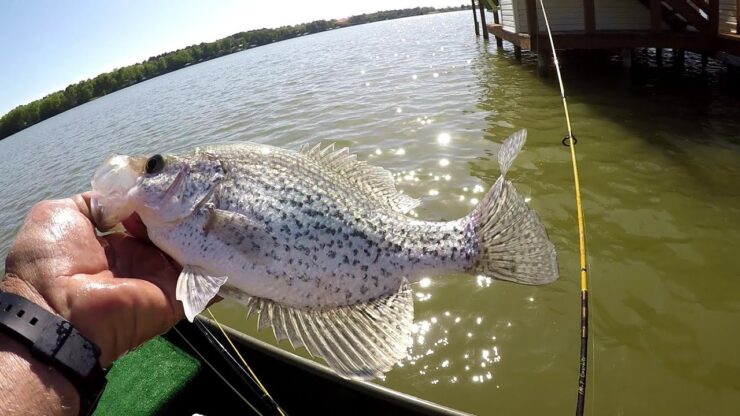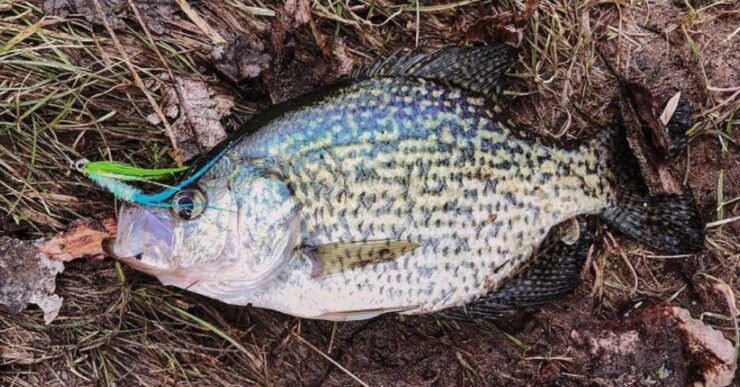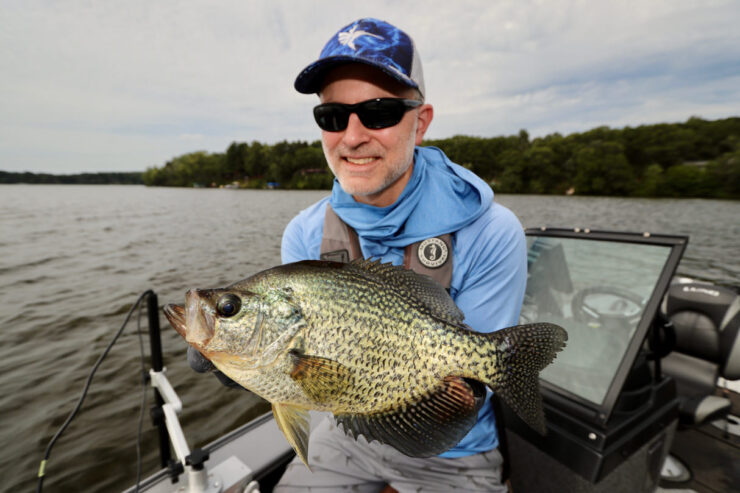Crappie behaviors and habits change immensely depending on the season. Basic knowledge is essential to understand where to find crappie in every season.
Table of Contents
ToggleSummer Crappie Fishing

As the temperature gets hotter, crappie will still follow the thermocline and suspend, but they will aggressively pursue schools of baitfish, and especially shad.
In the heat of summer, you will most likely find crappie along the edges of channels, river beds, bridge, and dock pilings or deep submerged cover, anywhere from 8-50′ deep.
The thermocline is the key to finding the correct depth. Also, in summer, night-fishing can sometimes be the most productive, but early morning and twilight are still good times as well.
In summer, live minnows are much more productive than jigs. Rig a small minnow (I usually hook them through the rear, so they stay lively and live longer) under a very light sinker or split shot, on light line.
You can use a slip-bobber if you want. I use a fish-finder rig with two minnows at different depths, and rig several rods, as many as four, sometimes, at different depths, until I find them (check to see if this is legal in your state, first).
Drift fishing is far and away from the most productive summer tactic. Drift along with likely spots with these rigs and be ready. You will often catch two fish at a time like this. Don’t neglect the main channels, because crappie is like moving water. Don’t forget that crappie is a major schooling fish.
Where you catch one, you will catch others.
Fall Crappie

When the dog-days of summer give way to cool, foggy mornings, it signals a change in crappie behavior from mostly moody, to an aggressive predator. As water temperatures drop, crappie begins to move once more into the mid-depths, usually along the same routes, they moved out on. They will cruise shallow flats in search of baitfish. The best times to search are early morning, twilight, and night time.
What actually triggers this behavior is as much the appearance of Midges, as water temperature. When Midges appear, baitfish such as shad and shiners will attack them voraciously, in turn attracting schools of hungry crappie.
When you see small baitfish jumping at this time of year, crappie will not be far behind.
Look for crappie schools along shallow bays, winding creek beds, and any other irregular bottom topography that can create a ‘holding’ zone. Where you find schools of baitfish, you will find crappie. One of my tricks in locating fall crappie is one I learned while striper fishing. Look for wheeling and diving sea-gulls, or other fish-eating birds.
Also, look for jumping schools of baitfish. Where you find them, you will find baitfish, and where you find baitfish in med-shallow water, you will find crappie. Crappie will once again become structure-oriented, so look for submerged timber, or another cover near drop-offs, in 5-15′ of water. Coves and points with shelves in 5-15′ of water are excellent places to search.
In rivers and tailraces, look for flats in 5-15 ‘ of water, near bottom structure and current breaks.
At this time of year, jigs, spinners, spoons, flies, and crank-baits (in small sizes) produce as well, or maybe better than minnows. In selecting colors, try to match the local baitfish as much as possible. Remember, what you see in color is not necessarily what the crappie are seeing. Crappie has excellent color vision, but remember, water stratifies light according to its wave length.
So a red lure will appear green beyond around 15′ deep. Yellow is the next to disappear, followed by chartreuse, green and blue. Black lures remain black at all depths, and white can be seen to great depths because black and white aren’t really colors. Black is a black color, and White amplifies whatever light there is. Stained water can change the appearance of colors as well. My best fall colors have always been chartreuse, and yellow.
This is a great time to try out Mepps, Panther-Martins, and Roostertail spinners. They can be magic in the fall. My favorite is the Mepps Black Fury spinner. Throw them out, and count down to the desired depth (usually, with a light line, you can figure 1′ drop for one second), then begin a medium speed retrieve. Jigs under a bobber work great, and diving crank-baits can be very productive.
Don’t stay at home because the weather is cooling down. This can be some of the best crappie fishing of the year if you prefer to fight fish and have no crowds.
Winter Crappie
When the water temperature approaches the mid-50s, crappie will begin their winter phase. Crappie is one of the most sought-after winter species nationwide and with good reason. When you find them, you can catch them.
But be advised, winter crappie fishing is not for everyone. It can be tough at times, due to the weather, and sometimes even dangerous. Safety is always important, but never more so than in winter. Hypothermia can strike without warning, and in some parts of the country, even frost-bite is a very real danger. Be sure to dress accordingly, have a cell phone within reach at all times, and stay alert to hazards.
Crappie are pretty consistent throughout the country, so what works down south as far as locating schools will also work on ice up north. As the water cools into the 50s, crappie will move to a shallow structure in 12-20 feet of water.
Look for submerged and standing timber, bridge pilings, boat docks, secondary creek channels, and other structures.
The best of all worlds is a shelf or channel that runs near a boat dock, bridge pilings, or weedy flats. In rivers, look near current breaks and irregular bottom features. They will remain in these locations until the water temperature rises enough to trigger the pre-spawn mode, starting the entire cycle over.
This is the time for cane poles and crappie poles. They are as sensitive as it gets. The hits will be gentle, but don’t fret. The fish aren’t moody. They will bite enthusiastically…just not hard.
The best bait is small minnows, but small tube jigs can be productive. Use light line and try to fish vertically as much as possible. There is no need to use a bobber, as most hits will be too light to detect with it. Fish will usually be near the bottom, within one or two feet, in cover.
If you’re not getting occasionally hung up and losing hooks, you’re not trying hard enough. Use the lightest gear possible, as the fish will be spooky and tentative. This is a great time to try out the Guitar String Bite Indicator described earlier since bites will be very gentle. The best times are, as usual, early morning, twilight, and nighttime.
It is not uncommon to catch your limit in short order in winter if you learn the ropes.
With a little determination and work, you can have fish-frys on a regular basis all through the winter, almost anywhere. And, you will definitely be far from the madding crowd. This is the sort of cave-man, “me against the world” fishing that I really enjoy.
Success at crappie fishing is to a large part, doing your homework. The rest is experience, so get out there and fish.
Happy fishing
Meet Maria Alexander, the fearless adventurer steering the ship at KayakPaddling.net. Her mission? To convince you that life’s too short for dry land and that the best stories always start with “So there I was in my kayak…”
Related Posts:
- Heavy Duty Fishing: 11 Best Rods And Reels For Big Fish 2025
- 12 Best Fishing Lures Ever 2025 - Baits That…
- 10 Best Saltwater Fishing Boats - Ultimate Angling Adventure
- 16 Best Kayak For Beginners 2025 - Kayaking Adventure Gear
- 10 Best Inflatable Kayak 2025 - Rivers, Lakes & Open Seas
- 12 Best Kayak GPS 2025 - Find Your Way to Adventure












